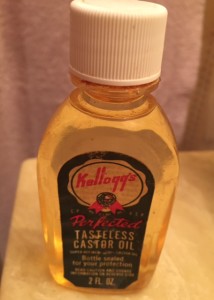
I know. You’re probably shaking your head and ready to hit the off button on this post, but sometimes I discover the most interesting things when I get curious about something. A few weeks ago I spotted this old bottle of castor oil in my medicine cabinet. It has to be from years and years ago and I have no idea where it came from or why I have it. So I thought it would make a good Throwback Thursday picture on my Facebook author page. But then, I decided to Google castor oil and found out more about castor oil than I could imagine.
What I Did Already Know about Castor Oil
When I was a kid, parents would sometimes dose a kid with castor oil if he or she started looking peaked. That’s an old-fashioned word for looking pale and sick. It was a cure-all. I think that was because the very mention of castor oil had a healing effect that made a kid immediately perk up to avoid having to take the awful tasting stuff. One of my earliest memories is of fighting like a banshee to keep from taking a dose of castor oil. I was normally a very well behaved child, but I won that round. I think my parents decided if I could fight that hard, maybe I wasn’t sick after all. Did you ever get a dose of castor oil?
Some parents also used castor oil as a threat of punishment. My mother didn’t do that, but thinking about taking it would have made me straighten up for sure. Of course, you will notice that this bottle claims it is “perfected” to be tasteless. You might also notice the bottle is still completely full, so I have no idea if it’s tasteless or not and I doubt I ever find out.
What I Didn’t Already Know about Castor Oil


Here is the castor oil plant and the castor oil beans that are processed to make castor oil or various other products. WW I plane engines used castor oil as a lubricant but petroleum based lubricants have mostly replace the castor oil lubricants now. It is used in food additives, as mold inhibitors, and more. One site even said the beans were sometimes made into jewelry. The plant as a crop is mostly grown in India, Brazil and China and often workers suffer harmful side effects from harvesting the seeds. The plant is sometimes used in an ornamental way in areas where it doesn’t naturally grow. It can be an evasive plant in certain climates.
The beans are highly toxic with a lethal dose of four to eight seeds for an adult. However, the death is so painful and extended that the beans are almost never used as a means for suicide even in areas where the plants grow like weeds. The seeds are also deadly to animals but with different lethal doses. While only six might kill a horse and eleven a dog, it would take eighty to kill a duck. I would guess that most animals take a wide path around the castor oil plants.
The Worst Historical Facts about Castor Oil
A heavy dose of castor oil was sometimes used in the past as a humiliating punishment for recalcitrant servants or political dissidents. In Fascist Italy, it was said Benito Mussolini kept his power over the country by “the bludgeon and castor oil.” Political dissidents were force-fed large quantities of castor oil by the Fascist squads. Victims sometimes died from the dehydrating effects of the oil-induced diarrhea along with the beatings they also received.
Chasing Down History Paths
So, my moment of curiosity about my old bottle of castor oil led me down several history paths. That’s how it is with research, although I do not plan to use anything about castor oil in my coming stories. Instead I’ll probably just stick that castor oil bottle back up on a shelf somewhere and forget about it. But seeing the beans and the plants makes me think that the mole bean plants I grew in the garden a few years ago were castor oil plants. Guess that’s something else I need to look up on the internet to see what other trails I can chase down.
Thanks for reading. What did you already know about castor oil?


Comments 3
I love researching things on the internet. Here’s another fact about castor oil beans:
Here’s the castor butterfly, which feeds on the castor oil plant:
https://en.wikipedia.org/wiki/Ariadne_merione
Here is the Eri Silk Moth which feeds on the leaves of the castor plant:
https://www.google.com/search?q=eri+silk+moth&hl=en&biw=1360&bih=674&site=webhp&tbm=isch&tbo=u&source=univ&sa=X&sqi=2&ved=0ahUKEwjcr_LK4fDKAhWC6iYKHTbJDv8QsAQIGw
With that being said, or typed, do you want to know a couple of differences between moths and butterflies? I’m glad you asked!
Anatomy
Moths have a frenulum, which is a wing-coupling device. Butterflies do not have frenulums. Frenulums join the forewing to the hind wing, so the wings can work in unison during flight.
Behavior
Butterflies are primariy diurnal, flying in the daytime. Moths are generally nocturnal, flying at night. However, there are moths that are diurnal, such as the buck moth and there are butterflies that are crepuscular, that is, flying at dawn and dusk.
Author
Very interesting, Nancy. I can always depend on you adding something good. Thanks for sharing the links and the information about how to tell the difference between moths and butterflies. I’ll look for those frenulums.
I know, frenulums. LOL What a goofy word.